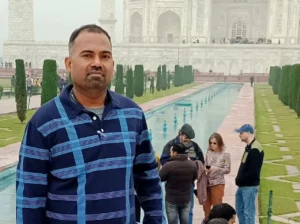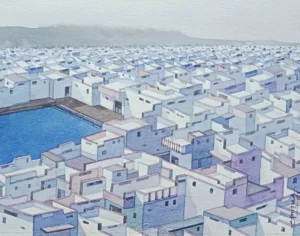Blue City’s -‘The Poetic Soul’
Recent Works by contemporary artist Madan Pawar
From 19th to 25th November 2024 at Jehangir Art Gallery, Kala Ghoda, Mumbai

Artist Madan Pawar
Madan Pawar does not abstract human settlements but rather renders them in shapes and hues that celebrate the ingenuity of those who build them despite the challenge of poverty and space. Skylines are not always tall towers – flat roofs or Chaths as they are called in India are communal places. The hues of the walls of the city of Jodhpur even though they are coloured convivial blue to protect from the sun they also serve as caste markers. Behind the immense beauty of Rajasthan there are deep divisions of caste and its continuous celebration.

An art school research trip to Rajasthan is when Madan Pawar discovered Jodhpur. Jodhpur is a city on the edge of the Thar desert from where wades of sand extend across the districts of Barmer and Jaisalmer into Pakistan until the fort towns of Umerkot in Tharparkar and Derawar in Bahawalpur. This is the region of the Marwar and the Dhatki, a community with a distinct language, ways of society, cuisine, music and clothing all attuned to the desert. A distinct frugality is seen in the way of life and thus are the ways of living. Homes are mud houses built of red stone created to insulate against the hot summers and cold winds of the winters.

On the slopes of the Mehrangarh Fort of Jodhpur just above the grid like modern city built by the Maharajas in the 20th century is the old city. Here different castes inhabit different quarters called Mohallas. Each one of them is adjacent to a gate or a Pol. We have people working with bamboo, the dyers making the distinct multic-oloured bandhani turbans and sarees, the sonars or goldsmiths gather on many thoroughfares and the Brahmins who hold pockets across these places give name to the city – the Blue City. Fortunately in the Republic of India people are free to not use colour as a social class or caste marker and the colour blue is the hue for social reform. The homes across Jodhpur are made of a lime mortar called ‘Surkhi Choona’, the blue glaze comes from the copper sulphate used in the lime mortar to protect it from termites. This use of indigo forms the colours of the walls giving the panorama from the fort a distinct azure tint as we see the homes gather around the slopes.
